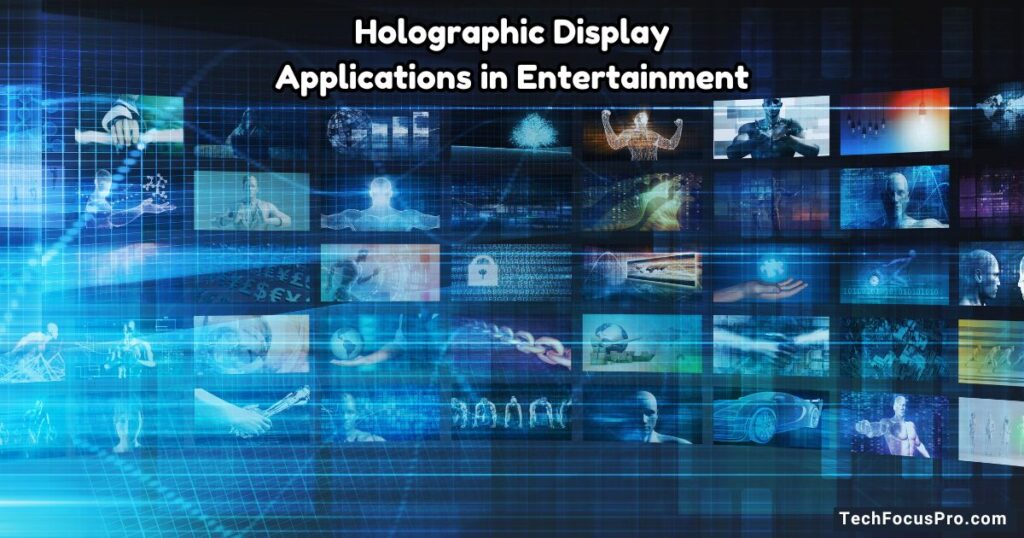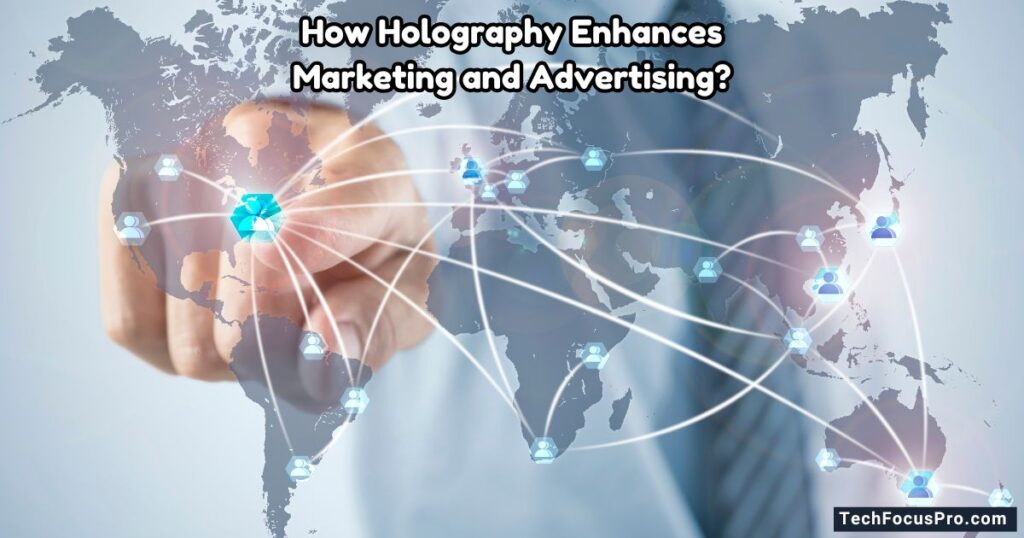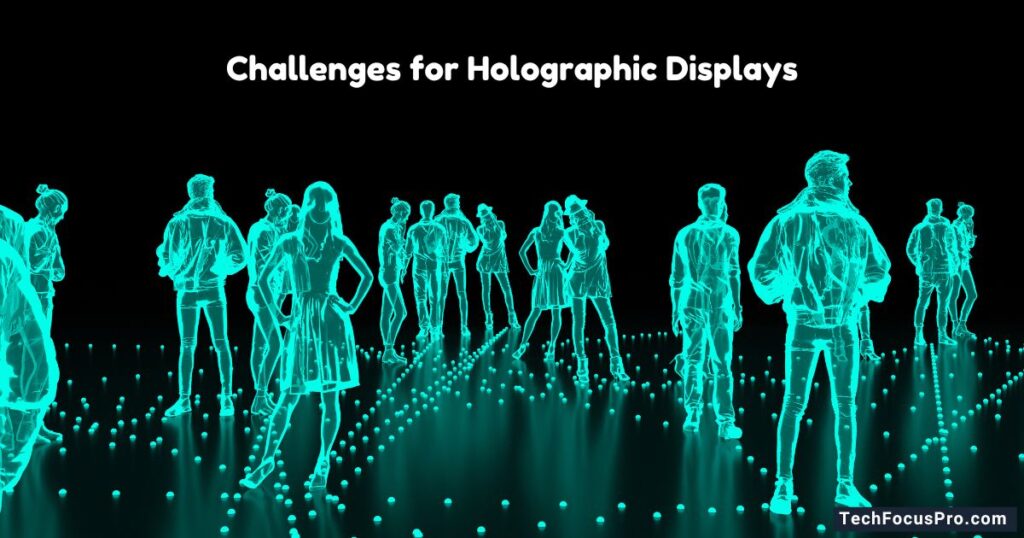What Are Holographic Displays and how are they Shaping the Future of Media?

Unlike traditional screens that merely project images on a flat surface, holographic displays create three-dimensional visuals that can be viewed from multiple angles.
This innovation can revolutionize how we interact with media and provide a more immersive experience that captures the audience’s attention.
Understanding what holographic displays are and how they function is essential for grasping their potential impact on the future of media. Keep reading!
What Are Holographic Displays?
Light interacting with an object reflects off its surfaces, conveying depth and clarity. This system captures and reconstructs those reflections to generate a 3D object representation.
The beauty of holographic displays is that they enable viewers to witness images from various viewpoints, making the experience much more dynamic than traditional screens. The holographic display technology can be used in various industries, including optics, computer graphics, gaming, and imaging systems.
Integrating digital technologies with traditional holography has allowed more precise control over image construction and manipulation.
Educational institutions and research organizations have also invested considerable resources into improving the efficiency and accessibility of holographic displays, with promising results.
By combining research and innovation, the potential for widespread use of holography in classrooms, museums, and conference rooms becomes more feasible as a practical tool for communication and learning.
Holographic Display Applications in Entertainment

One of the most exciting applications of holographic displays is in the entertainment industry. Cinemas, theaters, and gaming have already begun exploring how this technology can enhance audience engagement.
Holographic projections can create lifelike characters that interact with viewers, blurring the lines between reality and fiction.
Concerts and live events have also embraced holography, allowing artists to perform alongside holographic versions of themselves or even create entirely new shows that incorporate elements not feasible in a live setting.
Filmmakers can visualize characters in different settings and contexts, leading to stories that evolve in real-time based on audience interaction.
As technologies like virtual and augmented reality converge with holography, the potential for creating truly immersive experiences expands.
Entertainment visionaries are eager to explore how these technologies can integrate, setting a new standard for interactive storytelling that redefines conventional consumption patterns.
Transforming Education
Traditional teaching methods often rely on two-dimensional materials that can fail to fully engage students. In contrast, holograms can bring complex subjects to life in unique and insightful ways.
Imagine a biology class where students can observe a holographic human anatomy model, rotating and zooming in on parts of the body while interacting with the projection for in-depth learning.
This level of interaction can enhance comprehension and retention, helping students grasp intricate concepts that might otherwise be challenging.
Textbooks and videos alone cannot match the level of engagement that holographic displays aim to provide. They also encourage collaboration as students work together on projects involving this technology, fostering teamwork and critical thinking.
Various educational institutions have begun experimenting with holographic displays in their curricula, demonstrating measurable improvements in student engagement and comprehension.
How Holography Enhances Marketing and Advertising?

Advertising strategies seek to create memorable and engaging experiences, and holography fits perfectly into this narrative.
Read Also: Transform Your Business Space with a Digital Screens Player
Brands increasingly invest in holographic technology to unveil products at trade shows, giving potential customers an interactive experience that merely watching a video or viewing print ads cannot provide.
These displays allow brands to break through the clutter of traditional advertising, making messages more impactful and resonant with the audience.
Retailers can showcase products in 3D so that customers can visualize dimensions, features, and other essential aspects in a personalized way. As consumers interact with holograms, they forge emotional connections with the brand, fostering loyalty and preference.
The potential for customization further enhances the effectiveness of holographic advertising campaigns. Advertisers can tailor messages and visuals based on demographics or preferences in real time.
Companies that leverage this method will likely witness improved customer engagement and conversion rates, which are attractive investments in the future of marketing.
The Role of Holography in Healthcare
Holography is making waves in the healthcare sector, promising to revolutionize clinical practices and patient care. Medical professionals can leverage holographic displays to visualize complex surgical procedures.
By projecting 3D images of the patient’s anatomy, surgeons gain in-depth knowledge of the area they are operating in, enhancing their ability to strategize and execute procedures successfully.
An additional use for this technology lies in the educational aspects of medical training. Medical students can hone their skills by practicing on holographic patients before working with actual individuals, providing a risk-free environment to increase competence and confidence.
Such training helps bridge the gap between theoretical knowledge and practical application while emphasizing the importance of accurate and informed decision-making.
Holographic displays can facilitate remote consultations and diagnostics. Specialists can interact with 3D representations of medical conditions, regardless of geographical location.
This approach minimizes the impact of distance on patient care and streamlines the often time-sensitive processes that define healthcare.
Challenges for Holographic Displays

While the potential applications for holographic displays are vast, several challenges must be addressed before marked adoption becomes standard practice across industries.
First, the cost of implementing high-quality holographic displays remains relatively high. Like any emerging technology, economies of scale will enhance affordability over time, but initial financial hurdles must be overcome.
More industries are now exploring how holography can fit within their operating models; they require user-friendly setups that offer seamless integration.
Businesses must mitigate the steep learning curve often accompanying technology adoption to maintain productivity and embrace innovation.
Data privacy and security are also pressing concerns when utilizing advanced technologies like holography. Protecting sensitive patient, student, or consumer information will be critical as these displays become more commonplace in spaces involving personal data.
Addressing these challenges proactively will ensure that holographic technology can be embraced without hesitation.
The Future of Holographic Media
Continuous advancements in optics and imaging will enable higher-quality displays that are more immersive and widely available. Blockchain and cloud computing advancements may further augment holography by streamlining data processing and storage capabilities.
Industries are combining holographic displays with augmented and virtual reality to create unparalleled experiences that exceed current standards.
Future applications could evolve beyond mere projection, leading to more interactive interfaces where viewers manipulate holograms with their hands and voices.
Compatibility with social media and communication platforms may revolutionize how we connect and share our experiences.
Whether attending virtual events or collaborating on projects from around the globe, holographic displays will shape a dynamic future where interaction transcends physical limitations.
By embracing and investing in holographic technology today, stakeholders can take advantage of this innovation.
People Also Ask
What is a holographic display?
A holographic display is a type of display technology that creates three-dimensional images in space without requiring viewers to wear glasses or use additional equipment. It uses light diffraction to project realistic and lifelike images, which appear to float in the air, offering a dynamic and immersive visual experience.
Are holographic screens possible?
Yes, holographic screens are possible and are actively being developed. Advances in light technology, materials, and computational processing have made creating screens capable of projecting holographic images feasible. However, they are still evolving and not fully integrated with consumer technology.
What are holographic images used for?
Holographic images have diverse applications across multiple industries. They are used for educational purposes, allowing advanced visualization in science and medicine, entertainment for creative and futuristic visual effects, marketing for engaging advertisements, and even in field operations like architecture and design for 3D modeling and presentations.
How much do holographic displays cost?
The cost of holographic displays varies depending on their complexity, size, and purpose. Currently, prices range from a few thousand dollars to tens of thousands, making them accessible primarily to businesses and specialized markets.
Over time, as technology advances and production scales, costs are expected to decrease, potentially broadening accessibility.
What is an example of holographic?
An example of holographic technology is using augmented reality (AR) holograms in medical training. For instance, Microsoft HoloLens allows users to view and interact with 3D anatomical models, providing an immersive learning experience for medical students.
Another example is holographic displays during live performances, such as virtual concerts where artists are projected as lifelike holograms on stage. These applications showcase holographic technology’s versatility and innovation in education and entertainment.
How does a holographic work?
Holographic displays work by using light to create a 3D image that appears to float in space. This is done by splitting a beam of light into two parts, usually from a laser. One part shines directly on a recording surface, while the other bounces off the recorded object.
When these two beams meet, they create an interference pattern that captures the object’s shape and depth. Later, when light shines through this pattern, it recreates the 3D image for viewers.
What industries are benefiting from holographic displays?
Holographic displays are revolutionizing the entertainment, education, healthcare, and retail industries. They enable immersive storytelling in movies, create engaging visual aids for learning, assist in medical imaging, and enhance customer experiences with 3D product displays.
How are holographic displays shaping the future of media?
Holographic displays are set to transform media consumption by making content more interactive and immersive. They could redefine how we watch movies, play games, or attend virtual events, bridging the gap between digital and physical experiences.
Are holographic displays commercially available?
While still in the early stages of development, holographic displays are becoming more accessible. Some companies have introduced initial models for specific markets. Still, widespread adoption depends on technological advancements, cost reduction, and infrastructure development.
What challenges do holographic displays face?
Holographic displays face challenges such as high production costs, complex technical requirements, and the need for high-resolution content. Overcoming these hurdles will be essential for their mainstream adoption.
Could holographic displays replace traditional screens?
While holographic displays have the potential to revolutionize displays, they are unlikely to completely replace traditional screens shortly. Instead, they will complement existing technologies and offer new possibilities for specific use cases and industries.
Conclusion
Holographic displays represent a groundbreaking advancement in media and technology. By delivering immersive, three-dimensional experiences without the need for special equipment like glasses, they are redefining how we interact with digital content. From entertainment and education to healthcare and business, holographic displays have the potential to revolutionize multiple industries, making communication and visualization more engaging and impactful. As technology continues to evolve, the widespread adoption of holographic displays could transform our daily lives, bridging the gap between the physical and digital worlds in unprecedented ways.






